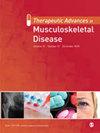Automated osteoporosis classification and T-score prediction using hip radiographs via deep learning algorithm
IF 3.4
2区 医学
Q2 RHEUMATOLOGY
引用次数: 0
Abstract
Background:Despite being the gold standard for diagnosing osteoporosis, dual-energy X-ray absorptiometry (DXA) is an underutilized screening tool for osteoporosis.Objectives:This study proposed and validated a controllable feature layer of a convolutional neural network (CNN) model with a preprocessing image algorithm to classify osteoporosis and predict T-score on the proximal hip region via simple hip radiographs.Design:This was a single-center, retrospective study.Methods:An image dataset of 3460 unilateral hip images from 1730 patients (age ⩾50 years) was retrospectively collected with matched DXA assessment for T-score for the targeted proximal hip regions to train (2473 unilateral hip images from 1430 patients) and test (497 unilateral hip images from 300 patients) the proposed CNN model. All images were processed with a fully automated CNN model, X1AI-Osteo.Results:The proposed screening tool illustrated a better performance (sensitivity: 97.2%; specificity: 95.6%; positive predictive value: 95.7%; negative predictive value: 97.1%; area under the curve: 0.96) than the open-sourced CNN models in predicting osteoporosis. Moreover, when combining variables, including age, body mass index, and sex as features in the training metric, there was high consistency in the T-score on the targeted hip regions between the proposed CNN model and the DXA ( r = 0.996, p < 0.001).Conclusion:The proposed CNN model may identify osteoporosis and predict T-scores on the targeted hip regions from simple hip radiographs with high accuracy, highlighting the future application for population-based opportunistic osteoporosis screening with low cost and high adaptability for a broader population at risk.Trial registration:TMU-JIRB N201909036.通过深度学习算法使用髋关节 X 光片自动进行骨质疏松症分类和 T 评分预测
背景:尽管双能 X 射线吸收测定法(DXA)是诊断骨质疏松症的金标准,但它仍是一种未得到充分利用的骨质疏松症筛查工具。目的:本研究提出并验证了卷积神经网络(CNN)模型的可控特征层与图像预处理算法,以通过简单的髋关节X光片对骨质疏松症进行分类并预测髋关节近端区域的 T 评分。设计:这是一项单中心、回顾性研究。方法:从1730名患者(年龄⩾50岁)中回顾性收集了3460张单侧髋关节图像数据集,并对目标髋关节近端区域的T-score进行了匹配的DXA评估,以训练(来自1430名患者的2473张单侧髋关节图像)和测试(来自300名患者的497张单侧髋关节图像)所提出的CNN模型。所有图像均由全自动 CNN 模型 X1AI-Osteo 处理。结果:与开放式筛查工具相比,所提出的筛查工具具有更好的性能(灵敏度:97.2%;特异性:95.6%;阳性预测值:95.7%;阴性预测值:97.1%;曲线下面积:0.96):0.96 )。此外,当将年龄、体重指数和性别等变量作为训练指标的特征时,所提出的 CNN 模型与 DXA 在目标髋关节区域的 T 值具有高度一致性 ( r = 0.996, p < 0.001)。结论:所提出的 CNN 模型可从简单的髋关节 X 光片中识别骨质疏松症并预测目标髋关节区域的 T 评分,准确率高,未来可应用于基于人群的机会性骨质疏松症筛查,成本低,适应性强,适用于更广泛的高危人群。
本文章由计算机程序翻译,如有差异,请以英文原文为准。
求助全文
约1分钟内获得全文
求助全文
来源期刊

Therapeutic Advances in Musculoskeletal Disease
Medicine-Rheumatology
CiteScore
6.80
自引率
4.80%
发文量
132
审稿时长
18 weeks
期刊介绍:
Therapeutic Advances in Musculoskeletal Disease delivers the highest quality peer-reviewed articles, reviews, and scholarly comment on pioneering efforts and innovative studies across all areas of musculoskeletal disease.
 求助内容:
求助内容: 应助结果提醒方式:
应助结果提醒方式:


